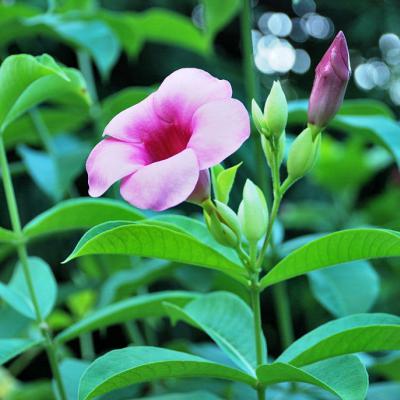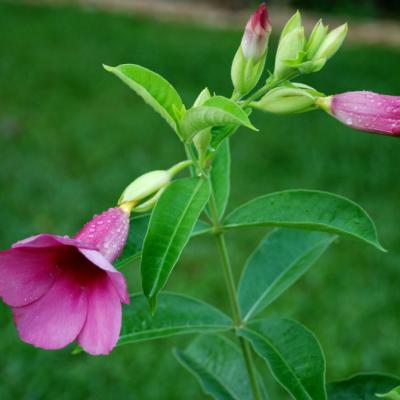Apocynaceae-Allamanda-blanchetii
Classification
- Botanical Family : Apocynaceae
- Genus : Allamanda
- Epithet : blanchetii
- German Family Name: Hundsgiftgewächse
- English Name: Purple Allamanda, Violet Allamanda
- Thai Name: บานบุรีสีกุหลาบ
- Thai Phonetic: baan buri si gu laab
- Author: A. DC.
- Height: 3.00
Water Requirements
Plant Type
Light Requirements
Cultivation
Allamanda blanchetii is growing on clay soils, sandy clay soils and feels well in moist substrates. The soil should not dry out.
Prefers for full flowering a sunny place or a place in light shade.
All parts of the plant are poisonous. The milky sap can cause skin irritations.
Allamanda blanchetii ist eine Mischung aus Kletterpflanze und Strauch und ist immergrün und blüht fast das ganze Jahr hindurch.
Die Triebe verholzen mit der Zeit und werden bis 3 m lang, wenn die Pflanze nicht verschnitten wird. Blätter oder Blüten wachsen nicht an den verholzten Ästen, sondern nur an den grünen neuen Triebenden. Es empfiehlt sich also ein regelmäßiger Schnitt. Der Strauch wird dann auch buschiger, wächst von unten heraus und ist blühwilliger.
Die Blüten sind purpur rot und trichterförmig. Die Blüte hat 5 sich überlappende Blütenblätter und ist in Zymen angeordnet.
Die Blätter sind mittelgrün. Die Früchte sind runde Kapseln. Kultivierte Formen bilden jedoch meistens keine Früchte.
Die Pflanze hat weder Dornen noch Ranken, sie verlangt deshalb Unterstützung, um seine aufrechte Form zu halten. Der Strauch dreht sich in eine bestimmten Richtung. Der Versuch, die Richtung zu ändern, kann zu Schäden an der Pflanze führen!
Allamanda blanchetii wächst auf Lehmböden, sandigen Lehmböden und fühlt sich in feuchten Substraten wohl. Der Boden sollte nicht austrocknen.
Bevorzugt zur Blütenbildung einen sonnigen bis leicht schattigen Platz.
Alle Teile der Pflanze sind giftig. Der Milchsaft kann zu Hautirritationen führen.
Vermehrung: durch Stecklinge von älteren Trieben, die aber noch Blätter haben, durch Aussaat oder Wurzelteilung.
Origin
Miscelaneous
Ethnomedical uses
The ethnomedical information is provided for general information only, it is not intended as guidance for medicinal use.
Leafes, flowers and roots are used.
Trinidad - Allamanda cathartica used in traditional medicine for treating malaria and jaundice.
A positive antibacterial wound healing could be demonstrated in a study in rats. (1)
Extracts of leaves, roots and flowers have been shown to have in vivo anti-tumour activity against leukaemia in mice, and against human carcinoma of the nasopharynx (nasal cavity and upper part of the throat) in culture. Leaf and root decoctions are used as a laxative and emetic in traditional medicine in a number of tropical countries, but large doses are toxic. (2)
(1) Evaluation of wound healing activity of Allamanda cathartica. L. and Laurus nobilis. L. extracts on rats Shivananda Nayak,1 Poorna Nalabothu,1 Steve Sandiford,1 Vidyasagar Bhogadi,1 and Andrew Adogwa2
Volksmedizinische Verwendung
Die Berichte über volksmedizinische Verwendung ist nur zur allgemeinen Information und nicht als medizinischer Ratgeber zu betrachten.
Verwendet werden Blätter, Blüten und Wurzel.
Trinidad - Allamanda cathartica wird als Mittel gegen Malaria und Gelbsucht eingesetzt.
Eine positive antibakterielle Wundheilung konnte in einer Studie an Ratten bewiesen werden. (1)
Extrakte von Blättern, Wurzeln und Blüten haben eine in vivo Anti-Tumor-Aktivität gegen Leukämie bei Mäusen und gegen die Karzinome des Nasopharynx (Nasenhöhle und oberen Teil des Halses) beim Menschen in angesetzter Kultur. Blätter- und Wurzelabkochungen werden als Abführmittel und Brechmittel in der traditionellen Medizin in einer Reihe von tropischen Ländern verwendet, aber große Dosen sind giftig. (2)
(1) Evaluation of wound healing activity of Allamanda cathartica. L. and Laurus nobilis. L. extracts on rats Shivananda Nayak,1 Poorna Nalabothu,1 Steve Sandiford,1 Vidyasagar Bhogadi,1 and Andrew Adogwa2
(2) http://www.kew.org/plants-fungi/Allamanda-cathartica.htm


